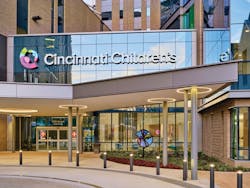2022 Lab of the Year Runner Up: Cincinnati Children’s Hospital Medical Center Clinical Laboratory
Cincinnati Children’s Hospital Medical Center (CCHMC) is one of the oldest and most distinguished pediatric hospitals in the United States, established in 1883. The academic pediatric acute care hospital has 634 beds.
Customer service
Cincinnati Children’s clinical laboratories’ customer service efforts strive to improve child health, transform delivery of care, and achieve the best medical outcomes, experience, and value for patients.
As a result of these laboratories’ commitment to customer service, several noteworthy accolades have been awarded in the past year. For instance, CCHMC clinical laboratories, which includes 10 outpatient collection sites, received the 2021 Outstanding Site of Care Award. This award recognizes a site of care that helped its team create a patient-centered culture.
Not only did the CCHMC laboratories receive awards, collectively, there were also awards given to individual employees within the laboratories for their outstanding customer service efforts.
John Simpson, a lab support technologist at the Liberty Campus, earned the 2021 All Star Award, which celebrates four stand-out individuals in the whole institution who show passion and commitment to patient family experience, putting the institution’s values in action in their everyday work.
Additionally, Emily Kimball, physician liaison and outreach associate in Clinical Laboratories, earned the Blood Drive Coordinator of the Year Award for 2020/2021 in Greater Cincinnati for going above and beyond expectations to increase blood donations among hospital staff.
To alleviate the rapidly growing influx of testing during the COVID pandemic, CCHMC laboratories worked to provide COVID-19 testing not only for patients, but also for our institution’s employees. They implemented approximately 25 molecular-based testing instruments, interfaced with the LIS, for rapid testing and coordination with the PCR laboratory for additional testing, adapting to be able to quickly transition to a high throughput model during times of high positivity rates. This included rapidly standing up drive-through testing for patients and employees, as well as shifting patient/employee testing between the central lab and PCR lab.
This adaptive care approach led to molecular based COVID testing turnaround times that were the benchmark for the region. Average TAT had historically been less than 15 hours with rapid testing being available in as little as 7 minutes.
Productivity
Throughout the COVID pandemic, CCHMC laboratories performed over 350,000 COVID tests. During the peaks of the pandemic, systems were stressed, and the supply chain was precarious. Labs were able to absorb the influx of patients and samples with few added positions by optimizing the workflow via IT and decentralization efforts. Taking the testing to the patients presented an opportunity for improved family satisfaction but also reduced the stress to the normal patient-flow processes. This was significantly important during the most recent nationwide staffing challenges.
In addition to improved COVID-19 productivity, CCHMC labs underwent some major upgrades, including moving the central laboratory to a new location; the creation of a Rapid Testing pod/bench that performs COVID-19, Rapid Strep A, Influenza A & B, blood gases, urine toxicology, urine hCG, mononucleosis, HIV, and RSV to allow prompt turnaround times of important tests for patient care; as well as centralization of staffing for similar platforms; and implementing one of the first automated line systems in a children’s hospital, with 6 integrated instruments, enabling transitions to working in pods instead of bench-based assignments.
CCHMC’s move also prompted the evaluation of the cesium blood irradiator, pushing the lab to participate in the Cesium Irradiator Replacement Project (CIRP) offered by the Department of Energy/National Nuclear Security Administrator’s Office of Radiological Security, successfully replacing 2 cesium irradiators, thereby decreasing national security threats, with one X-ray irradiator, increasing output and decreasing irradiation turnaround times (Figure 1).
Teamwork
To illustrate CCHMC’s laboratory’s commitment of teamwork, a seamless merge and relocation occurred, allowing almost 200 team members and all laboratory equipment to be relocated with no significant disruption in patient care, executed over a 4-week period and utilized a multiphase approach. The cross-functional move team ensured each laboratory section was kept abreast of the move plans and developments while maintaining service levels, sometimes at multiple locations.
The Omicron surge jumpstarted a sense of teamwork within CCHMC’s labs. During the rapid spread of the Omicron SARS-CoV-2 variant, CCHMC implemented a “One CCHMC” program to help with the staffing challenges.
The Laboratory Administration and Leadership teams stepped in to assist with COVID testing at one of the employee and patient collection locations within the community. Lab leaders who were formerly technologists came out of “retirement” and were trained and certified to run testing to provide same day turnaround for many of the employee collections. This enhanced the organization’s quick return-to-work initiative during this challenging time. These measures, as well as other volunteers across the organization, allowed CCHMC to maintain high levels of care for the children of the region.
Education and training
CCHMC prides itself on being a leader in supporting the growth, education, and development of its employees. Numerous educational and training initiatives have been implemented throughout the laboratory.
Over the past few months, CCHMC labs adapted to handle staffing challenges. Especially with regard to certified technologists, the clinical lab had to rethink how to approach staffing within the lab. Didactic modules for multiple laboratory disciplines were created to further educate those with science degrees but with minimal to no clinical lab exposure, eliminating the need to seek outside support for laboratory testing.
In addition to this added educational support for some staff, a career ladder was implemented, which improved the engagement of team members while also providing advancement opportunities to individuals who wish to grow within the laboratory setting. 44 team members took advantage of this opportunity to grow and advance within the organization. This initiative provides strength to the current retention strategy and awards individuals, in title and compensation, for learning new skills. The organization benefits from having staff members with a broadened scope of knowledge and expertise, thus strengthening our core of services.
Strategic outlook
Implementing and utilizing a strategic outlook plan within the clinical laboratories at CCHMC has been an ongoing project for the past 2 years, having established several specific avenues for strategy, as well as planning. All avenues focus on the organizational plan, with categories of Care, Cure, Community, and Culture. The avenues are an integrated operational plan, multiyear capital plan, and the Laboratory Practice Council.
The laboratory Practice Council focuses on 6 important domains of laboratory activity. Each domain has a delegated leader and medical staff representative as well as interested staff members from across the lab locations.
Activities accomplished through the practice council include:
- Development of project vetting and scoring process
- Situational Awareness and Shared Mental Model activities
- Standardized on-boarding activities
- Lab week, and other employee appreciation events
- Improved self-inspection process
Lab inspections
The Cincinnati Children’s clinical laboratories are CAP accredited at 9 physical locations and hold CLIA certificates. They are also subject to The Joint Commission for waived point of care testing at several locations, as well as FDA for transfusion services, and CMS and department of health inspections. This past year was a busy one for CCHMS regarding inspections. The pandemic changed the course for inspections, and CCHMS’ laboratories adapted very quickly by conducting one of the first “hybrid” inspections with primarily virtual TEAMS-based inspections with minimal on-site presence. The laboratory conducted 2 inspections via this route in June and August of 2020 and then spent the following year perfecting the process with the sharing of learnings with CAP and within the Children’s Hospital Association membership to aid in keeping the inspection process moving across the country.
In June 2021, CCHMS labs were inspected at the main campus by CAP colleagues. During this inspection, 19 different sections of the laboratory were reviewed covering 57 CAP checklists. Because much of the inspection was conducted remotely, the team had more time to review evidence and accumulate findings for a very thorough inspection.
In November 2021, the Liberty Campus laboratory and 5 neighborhood location laboratories experienced a more traditional onsite inspection. The 2-day inspection process covered 6 locations and 29 checklists. Additionally, the Ohio Department of Health selected the Liberty location as a subject of a validation survey. This resulted in an additional survey event in early January that verified the high-quality lab with no findings.
Overall, CCHMC laboratories experienced a very successful inspection cycle and were pleased with the quality of work coming from the teams. Laboratories attribute this success to a dedicated Quality Assurance team, consisting of a manager and 3 QA Specialists under the Laboratory Administration department, who coordinate and organize all regulatory activities. Additionally, there are 3 other QA specialist imbedded in the departments of Anatomical Pathology, Cancer and Blood Disease, and Human Genetics laboratories to help coordinate across the organization and laboratory structures.
Gail Castanho
Managing Editor
MLO






